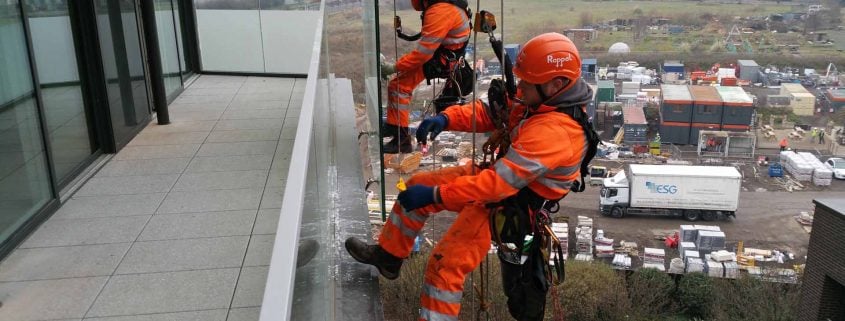Industrial Rope Access: What is it?
What is Rope Access? Industrial Rope Access is a relatively modern means of accessing to, and egressing from, a place of work. Typically, these areas are inherently difficult to access using conventional methods. Utilising Rope Access techniques allows for inspections, maintenance, repairs, and many other types of work to be safely undertaken in an efficient and cost-effective manner.
In very simple terms, a Rope Access system comprises of specifically designed and dedicated equipment including anchorages, ropes, harnesses, connectors, and other specialist devices that allows a professionally trained Rope Access technician to reach a point of work.
Rope Access was initially industrialised from a combination of techniques and practices used in the recreational sports of cave exploration and rock climbing. In the UK, Rope Access based systems were firstly implemented in the North Sea offshore oil and gas environment as a means to undertake maintenance and remedial works to the sectors remote installations and assets.
Development of the Rope Access Industry
It was further developed by a consortium of companies who promptly realised the significant advantages to using this lightweight, highly mobile, and cost-effective method of access. Unlike traditional methods of access such as scaffolding, cradles and elevated platforms, a Rope Access system generally has a minimal footprint, reducing the impact on other site activities.
Following its evolving reputation as a safe and viable method of access in the offshore sector, Rope Access swiftly migrated to onshore sites. Since its initial inception in the 1980’s, the methodology and best practice for undertaking Rope Access operations has seen continuous development on a global scale.
Several dedicated trade associations including UK based IRATA (The Industrial Rope Access Trade Association) and US based SPRAT (The Society of Professional Rope Access Technicians) have devised and implemented effective frameworks and technician training and assessment schemes.
The Rope Access System: Fundamental Principles
One of the core principles for a Rope Access safe system of work is to ensure that 100% redundancy is incorporated within the system. For a Rope Access system to comply with the international standard ISO 22846 and supporting British Standard BS 7985, the technician, whilst in suspension, must be attached to a minimum of two independently anchored systems.
Primarily, this is achieved by having an active or ‘working rope’ system that supports the weight of the technician. A secondary system is also installed and attached to the operative to form a safety or ‘back-up rope’ to provide an additional level of protection.
Basic Manoeuvres: Descent & Ascent
In a basic scenario, a Rope Access technician will connect to the ‘double rope’ system using a back-up device attached to the back-up rope and a descender device attached to the working rope. These devices are securely fixed to a full body harness worn by the technician, specifically designed for Rope Access use. The technician is able to travel down the rope in a controlled manner by operating the descending device to reach the required location of work. A decent made down a rope is commonly known as an abseil or rappel.
Going up! A standard Rope Access harness is also fitted with equipment that allows the technician to climb up a rope. These devices, generally known as ascenders, enable the operative to adjust their position and move vertically upwards or ascend, a manoeuvre typically referred to as jugging, jumaring or prusiking.
Lateral Movement: Transfer & Traverse
However, a Rope Access system is not limited to just working on vertical faces. With additional equipment, more complex systems can be designed and implemented that enable a team to access horizontally or diagonally across a plane.
Whether using a manoeuvre referred to as a ‘Rope-to-Rope Transfer’ or more advanced systems such as a ‘Tyrolean Traverse’, it is possible for a Rope Access technician to move in three-dimensional space, travelling between all x, y, and z axis.
Rope Access: Resources & Informative Links
Need to find out more? Don’t hesitate to get in touch with us via our contact page or call us on 0800 888 6638 for further information or advice. Check out these external links to additional informative resources:




